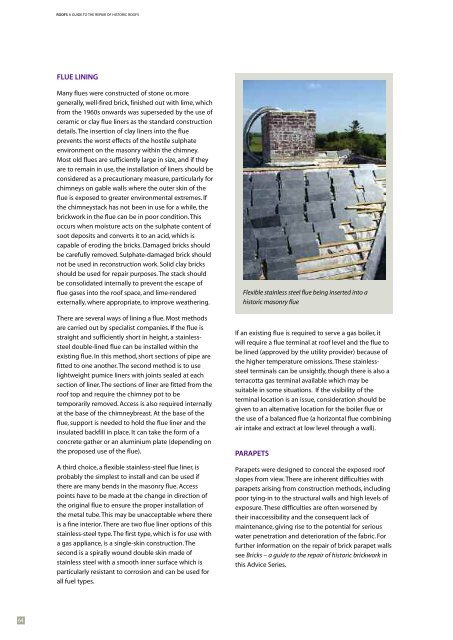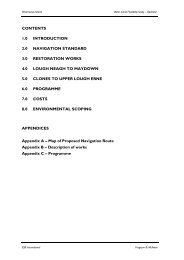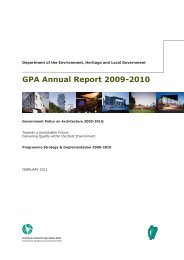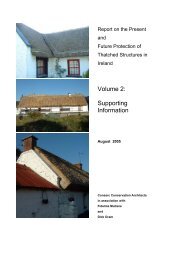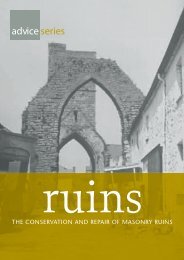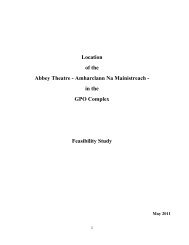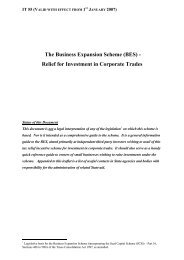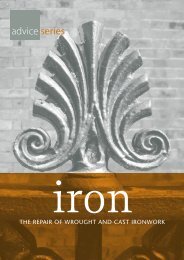A Guide to the Repair of Historic Roofs - Dublin City Council
A Guide to the Repair of Historic Roofs - Dublin City Council
A Guide to the Repair of Historic Roofs - Dublin City Council
Create successful ePaper yourself
Turn your PDF publications into a flip-book with our unique Google optimized e-Paper software.
ROOFS A GUIDE TO THE REPAIR OF HISTORIC ROOFSFLUE LININGMany flues were constructed <strong>of</strong> s<strong>to</strong>ne or, moregenerally, well-fired brick, finished out with lime, whichfrom <strong>the</strong> 1960s onwards was superseded by <strong>the</strong> use <strong>of</strong>ceramic or clay flue liners as <strong>the</strong> standard constructiondetails. The insertion <strong>of</strong> clay liners in<strong>to</strong> <strong>the</strong> flueprevents <strong>the</strong> worst effects <strong>of</strong> <strong>the</strong> hostile sulphateenvironment on <strong>the</strong> masonry within <strong>the</strong> chimney.Most old flues are sufficiently large in size, and if <strong>the</strong>yare <strong>to</strong> remain in use, <strong>the</strong> installation <strong>of</strong> liners should beconsidered as a precautionary measure, particularly forchimneys on gable walls where <strong>the</strong> outer skin <strong>of</strong> <strong>the</strong>flue is exposed <strong>to</strong> greater environmental extremes. If<strong>the</strong> chimneystack has not been in use for a while, <strong>the</strong>brickwork in <strong>the</strong> flue can be in poor condition. Thisoccurs when moisture acts on <strong>the</strong> sulphate content <strong>of</strong>soot deposits and converts it <strong>to</strong> an acid, which iscapable <strong>of</strong> eroding <strong>the</strong> bricks. Damaged bricks shouldbe carefully removed. Sulphate-damaged brick shouldnot be used in reconstruction work. Solid clay bricksshould be used for repair purposes. The stack shouldbe consolidated internally <strong>to</strong> prevent <strong>the</strong> escape <strong>of</strong>flue gases in<strong>to</strong> <strong>the</strong> ro<strong>of</strong> space, and lime-renderedexternally, where appropriate, <strong>to</strong> improve wea<strong>the</strong>ring.There are several ways <strong>of</strong> lining a flue. Most methodsare carried out by specialist companies. If <strong>the</strong> flue isstraight and sufficiently short in height, a stainlesssteeldouble-lined flue can be installed within <strong>the</strong>existing flue. In this method, short sections <strong>of</strong> pipe arefitted <strong>to</strong> one ano<strong>the</strong>r. The second method is <strong>to</strong> uselightweight pumice liners with joints sealed at eachsection <strong>of</strong> liner. The sections <strong>of</strong> liner are fitted from <strong>the</strong>ro<strong>of</strong> <strong>to</strong>p and require <strong>the</strong> chimney pot <strong>to</strong> betemporarily removed. Access is also required internallyat <strong>the</strong> base <strong>of</strong> <strong>the</strong> chimneybreast. At <strong>the</strong> base <strong>of</strong> <strong>the</strong>flue, support is needed <strong>to</strong> hold <strong>the</strong> flue liner and <strong>the</strong>insulated backfill in place. It can take <strong>the</strong> form <strong>of</strong> aconcrete ga<strong>the</strong>r or an aluminium plate (depending on<strong>the</strong> proposed use <strong>of</strong> <strong>the</strong> flue).A third choice, a flexible stainless-steel flue liner, isprobably <strong>the</strong> simplest <strong>to</strong> install and can be used if<strong>the</strong>re are many bends in <strong>the</strong> masonry flue. Accesspoints have <strong>to</strong> be made at <strong>the</strong> change in direction <strong>of</strong><strong>the</strong> original flue <strong>to</strong> ensure <strong>the</strong> proper installation <strong>of</strong><strong>the</strong> metal tube. This may be unacceptable where <strong>the</strong>reis a fine interior. There are two flue liner options <strong>of</strong> thisstainless-steel type. The first type, which is for use witha gas appliance, is a single-skin construction. Thesecond is a spirally wound double skin made <strong>of</strong>stainless steel with a smooth inner surface which isparticularly resistant <strong>to</strong> corrosion and can be used forall fuel types.Flexible stainless steel flue being inserted in<strong>to</strong> ahis<strong>to</strong>ric masonry flueIf an existing flue is required <strong>to</strong> serve a gas boiler, itwill require a flue terminal at ro<strong>of</strong> level and <strong>the</strong> flue <strong>to</strong>be lined (approved by <strong>the</strong> utility provider) because <strong>of</strong><strong>the</strong> higher temperature omissions. These stainlesssteelterminals can be unsightly, though <strong>the</strong>re is also aterracotta gas terminal available which may besuitable in some situations. If <strong>the</strong> visibility <strong>of</strong> <strong>the</strong>terminal location is an issue, consideration should begiven <strong>to</strong> an alternative location for <strong>the</strong> boiler flue or<strong>the</strong> use <strong>of</strong> a balanced flue (a horizontal flue combiningair intake and extract at low level through a wall).PARAPETSParapets were designed <strong>to</strong> conceal <strong>the</strong> exposed ro<strong>of</strong>slopes from view. There are inherent difficulties withparapets arising from construction methods, includingpoor tying-in <strong>to</strong> <strong>the</strong> structural walls and high levels <strong>of</strong>exposure. These difficulties are <strong>of</strong>ten worsened by<strong>the</strong>ir inaccessibility and <strong>the</strong> consequent lack <strong>of</strong>maintenance, giving rise <strong>to</strong> <strong>the</strong> potential for seriouswater penetration and deterioration <strong>of</strong> <strong>the</strong> fabric. Forfur<strong>the</strong>r information on <strong>the</strong> repair <strong>of</strong> brick parapet wallssee Bricks – a guide <strong>to</strong> <strong>the</strong> repair <strong>of</strong> his<strong>to</strong>ric brickwork inthis Advice Series.64


